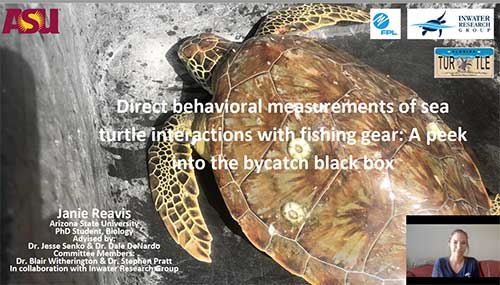Grant: 21-003R
Project Title: Behavioral responses of green and loggerhead sea turtles to fishing gear and bycatch reduction technologies
Project Manager: Janie Reavis
Organization: Inwater Research Group (Non-Profit Organization)
Grant Amount: $15,680.00
Completion Date: 2022-11-16
Summary: This project will examine sea turtles' interactions with anthropogenic hazards, mainly fishery-related gear, and how technologies intended to deter turtles from these hazards impact these interactions. We will use choice trials in an experimental tank and in the intake canal at the St. Lucie Nuclear Power Plant to examine sea turtle behavior in relation to fishing gear and bycatch reduction technologies. This unique study system enables us to observe the behavior of sea turtles in both a controlled and semi-controlled setting with the sea turtles entrained in the intake canal as our study subjects. Based on the results of this study, we will develop more effective deterrents and reduce sea turtle mortality in Florida fisheries.  Results: Incidental capture, or bycatch, of marine species is a global conservation concern. Interactions with fishing gear can cause mortality in air-breathing marine megafauna, including sea turtles. Despite this, interactions between sea turtles and fishing gear—from a behavior standpoint—are not sufficiently documented or described in the literature. Understanding sea turtle behavior in relation to fishing gear is key to discovering how they become entangled or entrapped in gear. This information can also be used to reduce fisheries interactions. However, recording and analyzing these behaviors is difficult and time intensive. In this study, we present a machine learning-based sea turtle behavior recognition scheme. The proposed method utilizes visual object tracking and orientation estimation tasks to extract important features that are used for recognizing behaviors of interest with green turtles (Chelonia mydas) as the study subject. Then, these features are combined in a color-coded feature image that represents the turtle behaviors occurring in a limited time frame. These spatiotemporal feature images are used along a deep
convolutional neural network model to recognize the desired behaviors, specifically evasive behaviors which we have labeled “reversal” and “U-turn.” Experimental results show that the proposed method achieves an average F1 score of 85% in recognizing the target behavior patterns. This method is intended to be a tool for discovering why sea turtles become entangled in gillnet fishing gear. - Reavis JL, Demir HS,
Witherington BE, Bresette MJ, Blain Christen J, Senko JF and Ozev S (2021) Revealing Sea Turtle Behavior in Relation to Fishing Gear Using Color-Coded Spatiotemporal Motion Patterns With Deep Neural Networks. Front. Mar. Sci. 8:785357. doi: 10.3389/fmars.2021.785357
Results: Incidental capture, or bycatch, of marine species is a global conservation concern. Interactions with fishing gear can cause mortality in air-breathing marine megafauna, including sea turtles. Despite this, interactions between sea turtles and fishing gear—from a behavior standpoint—are not sufficiently documented or described in the literature. Understanding sea turtle behavior in relation to fishing gear is key to discovering how they become entangled or entrapped in gear. This information can also be used to reduce fisheries interactions. However, recording and analyzing these behaviors is difficult and time intensive. In this study, we present a machine learning-based sea turtle behavior recognition scheme. The proposed method utilizes visual object tracking and orientation estimation tasks to extract important features that are used for recognizing behaviors of interest with green turtles (Chelonia mydas) as the study subject. Then, these features are combined in a color-coded feature image that represents the turtle behaviors occurring in a limited time frame. These spatiotemporal feature images are used along a deep
convolutional neural network model to recognize the desired behaviors, specifically evasive behaviors which we have labeled “reversal” and “U-turn.” Experimental results show that the proposed method achieves an average F1 score of 85% in recognizing the target behavior patterns. This method is intended to be a tool for discovering why sea turtles become entangled in gillnet fishing gear. - Reavis JL, Demir HS,
Witherington BE, Bresette MJ, Blain Christen J, Senko JF and Ozev S (2021) Revealing Sea Turtle Behavior in Relation to Fishing Gear Using Color-Coded Spatiotemporal Motion Patterns With Deep Neural Networks. Front. Mar. Sci. 8:785357. doi: 10.3389/fmars.2021.785357